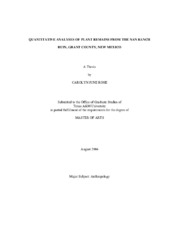| dc.description.abstract | The general architectural transition from semi-subterranean pithouses to surface pueblos that occurred across the prehistoric North American Southwest has been attributed to increased agricultural dependence. In this study macrobotanical ubiquity scores, percentages, diversity, and richness were compared between pithouse and pueblo assemblages from the NAN Ranch Ruin, Grant County, New Mexico, to assess whether or not the macrobotanical evidence supported a link between increased agricultural dependence and the pithouse to pueblo transition at the site. Rarely were differences between values of relative macrobotanical abundance from the two periods found to be significant. Ubiquity analyses provided some evidence for greater agricultural dependence in the pueblo period. Ubiquity scores declined between the pithouse and pueblo periods for all taxa recovered from both periods, except maize (Zea mays L.) and goosefoot (Chenopodium spp.), an aggressive agricultural weed, probably because the puebloan occupants of the NAN Ranch Ruin relied more on maize agriculture than did the pithouse occupants at the site. Cotton (Gossypium hirsutum L.) was recovered only from pueblo deposits, perhaps indicating that this crop was not grown during the earlier pithouse period. Significant differences that were detected between pithouse and pueblo values of relative macrobotanical abundance were most likely due to the effect of variable sample sizes, when all samples were combined for analysis, regardless of their recovery contexts. Although the effect of variable sample volume was controlled by analysis of sub-samples representing five liters of excavated soil, the sub-samples varied in the number of specimens present. This finding illustrates the effect of variable numbers of specimens per sample on measures of relative abundance and the importance of comparing similar contexts in quantitative studies. | en |


